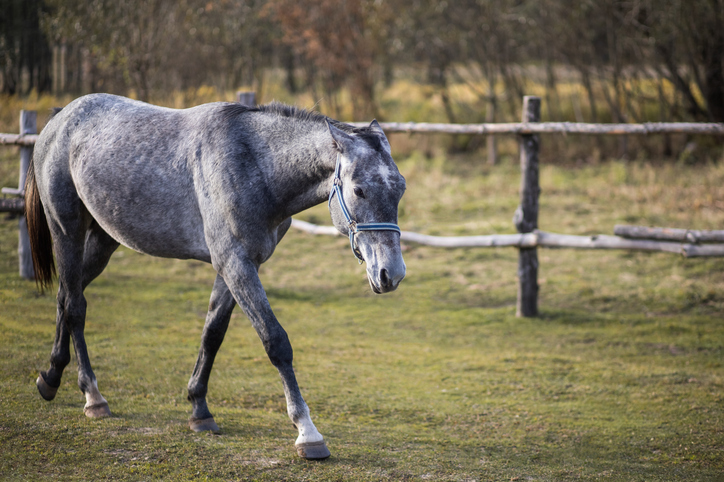A Tale of Two Species: Melanoma in Horses and Humans


We recently discussed melanoma, a type of skin cancer, with University of Kentucky experts Dr. John D’Orazio, pediatric oncologist and chief of pediatric hematology-oncology at Kentucky Children’s Hospital, and Dr. Emma Adam, equine research and outreach veterinarian for UK’s Gluck Equine Research Center. The two coordinated a presentation on melanoma — addressing the parallels and differences in human and equine melanomas — for an international research conference hosted in Lexington in 2021. They have some interesting insights to help bring the topic of melanoma home, particularly in the heart of horse country.
Equine melanomas: A ‘gray area’
For some horse-racing enthusiasts, “betting on the gray” is a tradition. But one thing you might not know about gray horses is that – unlike other horses – they are quite prone to melanomas, especially as they age. In gray horses though, melanomas – while common – are typically benign, or non-cancerous, Dr. Adam said, and that’s because they are “non-malignant space-occupying lesions.” When they rise to the level of being a threat, “it’s the fact that they are space-occupying lesions (which can impinge on other structures) that becomes the issue.”
“Melanoma in non-gray horses is where we tend to see the malignancy, but it's exceptionally rare,” Dr. Adam said.
Human melanomas: A dangerous difference
Contrastingly, in humans, melanomas present a much greater threat. “In humans, the disease is very aggressive,” Dr. D’Orazio said. “It’s the one that causes the most deaths from skin cancer, with approximately 8,000 fatalities annually in the U.S. alone.”
In gray horses, melanoma “tends to be this chronic nuisance of a thing, and it doesn't move from one place in the horse necessarily to other places in the body,” Dr. D’Orazio said.
“We tend to see it as they get older, and it tends to be in certain locations on their body,” Dr. Adam said.
Melanoma in horses tends to show up under the tail or under the jaw. While it can be burdensome, it is typically not life-threatening.
In people, it’s the spread of melanoma tumors that can be fatal. “If it’s moved around by the time you take out the first tumor, the second tumor can sprout up in the lungs, other places in the skin, the brain, really anywhere,” Dr. D’Orazio said.
‘No safe tanning’
“In general, the melanomas in horses are very different than the melanomas in people,” Dr. D’Orazio said. For gray horses, the risk is in their genes and not related to sun exposure.
Gray horses, born with black skin, are fully pigmented at birth but their hair loses pigment over their lifetimes. “The ones that lose it the fastest are the ones that get these melanomas that are very jet black – they are pigmented lesions,” Dr. D’Orazio said.
A mutation in the syntaxin-17 gene causes these horses to gray with age and contributes to the development of melanoma.
In humans, exposure to ultraviolet (UV) light – as well as variants in the melanocortin 1 receptor (MC1R gene) – increases the risk of developing melanoma and skin cancer. MC1R regulates pigmentation, and variants in the MC1R gene found in fair-skinned people make them more susceptible to UV exposure and melanoma.
“And so our research into melanoma has really been trying to understand why these fair-skinned people don't tan so much in response to sunlight or UV radiation, but they burn instead,” Dr. D’Orazio said.
“These blistering sunburns really correlate with melanoma risk,” he explained. That’s why it’s critically important to avoid sunburns and to limit your UV exposure. “Ultimately what causes melanoma are these lesions in the DNA that have been caused by UV light.”
“There is no safe tanning right now,” Dr. D’Orazio said. “This idea that I’m going to get a base tan before I go on vacation to Hawaii, so I’m going to stay out in the sun and get a little bit of tan. … It’s all UV damage to your DNA, whether it happens in Lexington or Hawaii.”
Similarly, UV exposure can be harmful to horses with areas of non-pigmented skin, where sun damage can cause serious disease such as squamous cell carcinoma. “We'll see it on horses that have a lot of white on their face or their legs for example,” Dr. Adam said.
Just as humans wear UV-protective clothing, horses with non-pigmented skin around the eyes can be protected with fly masks, which not only keep the flies out but reduce exposure to UV radiation.
Prevention
Dr. D’Orazio offers these tips to reduce your melanoma risk.
- Limit UV (ultraviolet) exposure – avoid tanning and tanning beds.
- Avoid sunburns.
- Wear sunblock outside during peak hours – 10 a.m. to 4 p.m.
- Use sunblock and reapply as directed (otherwise, it has diminished effectiveness).
- Stay in the shade.
- Wear protective garments, like a hat or rashguard.
- Protect your kids – their skin is more sensitive and they tend to be outside recreationally more, making them particularly at risk for sunburns.
Detection
If you develop melanoma, “the key is to find out about it as soon as you can,” Dr. D’Orazio said. Check your skin for moles or spots regularly, particularly if you are fair-skinned, and especially if you’re a redhead. Bring any changes in your skin to the attention of your doctor and remember your “ABCDEs” as you are doing your skin check:
- Asymmetry: The two halves of a mole or skin spot don’t match; it’s not a circle.
- Border irregularity: It has an irregular, ragged or blurred border.
- Color: The color is changing (for example, it was dark brown and has turned black in one area).
- Diameter: It is growing larger.
- Elevation: The surface is changing (you can now feel it).





